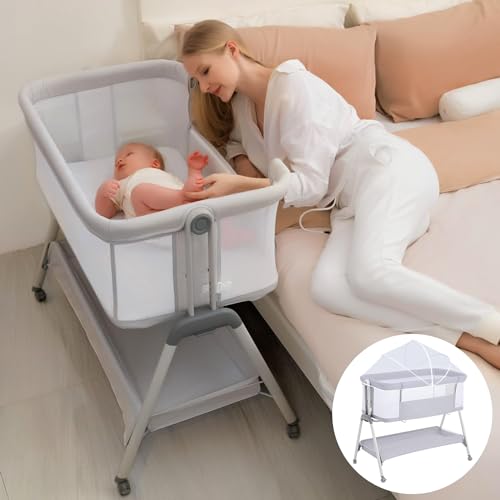Bedside Sleeper Cot
A bedside sleeper cot (also known as a bassinet) fixes to the side of your bed so baby can be close enough for night feeding but safe within their own space to sleep. Our mothers love that they are simple to reach and also rotate the sides or drop them to get closer.
Safety
The bedside sleeper lets parents monitor, soothe and feed their infants at the night without worrying about the dangers of bed-sharing. This could lead to Sudden Infant Death Syndrome. The cots are in line with NHS guidelines for co-sleeping and are recommended by childcare experts, such as Dr. McKenna director of the Mother-Baby Behavioural Sleep Laboratory.
They also provide immediate nursing support and help babies feel more secure by keeping them close, creating healthy attachments that assist with milestones in development. Parents should look for bassinets that are easy to clean, safe to use, and have been endorsed by a trusted organization like JPMA.

In 2023, ASTM updated its version of the bedside sleeping voluntary standard F2906 in response to newer products that convert from an infant bassinet to a bedside sleeper, by dropping one side rail adjacent to an adult bed, which allows certain areas of the lower portion to be elevated level above the mattress, which poses an increased risk for entrapment. CPSC's direct final rule incorporates by reference this 2023 revision to the current mandatory standard under section 104 of the Consumer Product Safety Improvement Act of 2008 (CPSIA) for products for toddlers and infants that have been in use for more than 180 days and is expected to decrease the risk of injury.
bedside cots uk is important to remember that a bassinet or bedside sleeper, should not be used in conjunction with pillows or blankets. This can pose the risk of suffocation since many young babies cannot lift their heads sufficiently to keep them from soft objects. Additionally, a reclining position can cause the head to slide forward, obstructing their airway. Always place your child on their backs while using a crib, bassinet or play yard. Use a fitted sheet that is in compliance with the federal requirements.
Convenience
It is important to keep your baby close throughout the night. This can help create bonds between parents and newborns. Bassinets that sleep in bed are securely attached to the sides of your bed and allow you to easily reach your baby for middle-of-the-night diaper changes, feedings and comforting. We looked for models that had mesh sides that were transparent enough to allow for visibility, so you could monitor your baby without needing to leave the bed.
You should make sure that the bassinet is in compliance with the American Consumer Product Safety Commission's (CPSC) requirements and is deemed safe for babies. You should look for a bassinet that has a wide base and a sturdy attachment system. A mattress that is breathable should be considered.
Look for a model with a manual rocking feature that's gentle on your baby and can help settle them to sleep. Some models also come with tilt options, which can be helpful for infants suffering from reflux or colic, but should only be used with the advice of your GP or health professional.
Some bassinets include a mattress, while others require that you purchase one separately. Be sure to purchase the right mattress to fit in your bedside bassinet, since second-hand mattresses can be too soft and carry a risk of SIDS. You'll also have to purchase a breathable fitted sheet and muslin blanket for your baby. Be sure to check the fabric lining. The foam mattress are machine washable for ease of cleaning. A basket or shelf for storage is a useful feature to store essentials such as nappies, clothes and muslins. There are models with wheels to enable it to be moved around the home.
Support for breastfeeding
If you decide to breastfeed, a bedside sleeper cot can help you to make the most of your night-time feedings. By securing it to your bed, it permits you to reach easily when baby wakes for a feed. The cot's side can then drop down to create a bassinet that is shallow for safe side-by-side sleeping. Some models also tilt to help with reflux.
The curved sides make it easy to see and help lift your baby up to feed. They won't roll off the side. Some bedside sleeper cribs have an automatic rocking feature that will help your child relax and encourage them to fall back asleep faster after a feeding.
A cosy fabric and machine washable and removable bedding are useful in keeping your baby clean. Some models have gentle rocking and vibration functions which can help soothe your baby to sleep. The storage space is a benefit for breastfeeding mothers.
It is beneficial for breastfeeding mothers to share their bed with their babies. This allows them to form an intimate bond while they sleep. Research has proven that infants who are breastfed and sleep together have much better outcomes than bottle-feeding infants. It is essential to be aware of the dangers and practices associated with sharing the bed with a baby and to choose a mattress that is safe for your baby.
Some in-bed sleepers have soft surfaces or padding along their edges, which could cause your baby to become trapped. Be sure to not let the mattress slide backwards. This could cause an opening through which your child can crawl or roll.
If you're concerned about the safety of a bedside sleeper take a look at attending an LLL meeting or talking with an experienced Sleep Leader to know more about the sleep habits of breastfeeding mothers and their babies. They can explain how to create a safe sleeping environment for your baby and help you to understand the dangers of SIDS. They will also teach you about the'sweet sleep' of nursing mothers, which has many of the same protection factors as breastfeeding.
